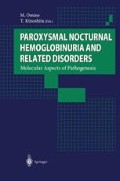Abstract
Patients with paroxysmal nocturnal hemoglobinuria (PNH) have one or a few clones of mutant hematopoietic stem cells defective in glycosylphosphatidylinositol (GPI) synthesis due to somatic mutation in the X-linked gene PIG-A. The mutant stem cell clone dominates hematopoiesis, the mechanism of which is unclear. To test whether lacks of multiple GPI-anchored proteins result in dysregulation and expansion of stem cells, we generated mice in which GPI-anchor negative cells are present only in hematopoietic system. We transplanted lethally irradiated mice with female fetal liver cells bearing one allele of Piga gene disrupted by conditional gene targeting. Due to the X-chromosome inactivation, a significant fraction of the hematopoietic stem cells in fetal livers were GPI-anchor negative. In the transplanted mice, cells of all hematopoietic lineages contained GPI-anchor negative cells. The proportions of GPI-anchor negative cells in various blood cell lineages were stable for 42 weeks, indicating that Piga mutation alone does not cause dominance of the mutant stem cells and that other changes are involved in pathogenesis of PNH.
There are two hypothetical mechanisms for clonal expansion of GPI cells. The one is that the mutant cells are selected by autoreactive cytotoxic cells. The other is that the mutant cell itself gets intrinsic ability to expand by the second hit. Using the previously reported PNH mice in the immunological model system, we studiied to prove the former hypothesis.
Access this chapter
Tax calculation will be finalised at checkout
Purchases are for personal use only
References
Miyata T, Takeda J, lida Y, Yamada N, Inoue N, Takahashi M, Maeda K, Kitani T, Kinoshita T (1993) Cloning of PIG-A, a component in the early step of GPI-anchor biosynthesis. Science 259:1318–1320
Takeda J, Miyata T, Kawagoe K, lida Y, Endo Y, Fujita T, Takahashi M, Kitani T, Kinoshita T (1993) Deficiency of the GPI anchor caused by a somatic mutation of the PIG-A gene in paroxysmal nocturnal hemoglobinuria. Cell 73:703–711
Bessler M, Mason PJ, Hillmen P, Miyata T, Yamada N, Takeda J, Luzzatto L, Kinoshita T (1994) Paroxysmal nocturnal haemoglobinuria (PNH) is caused by somatic mutations in the PIG-A gene. Embo J 13:110–117
Luzzatto L, Bessler M, Rotoli B (1997) Somatic mutations in paroxysmal nocturnal hemoglobinuria: A blessing in disguise? Cell 88:1–4
Young NS (1992) The problem of clonality in aplastic anemia: Dr Dameshek’s riddle, restated. Blood 79:1385–1392
Rotoli B, Luzzatto L (1989) Paroxysmal nocturnal hemoglobinuria. Semin Hematol 26:201–207
Rosse WF (1992) Paroxysmal nocturnal hemoglobinuria. Curr Top Microbiol Immunol 178:163–173
Kinoshita T, Inoue N, Takeda J (1995) Defective glycosyl phosphatidylinositol anchor synthesis and paroxysmal nocturnal hemoglobinuria. Adv. Immunol. 60:57–103
Kawagoe K, Kitamura D, Okabe M, Taniuchi I, Ikawa M, Watanabe T, Kinoshita T, Takeda J (1996) GPI-anchor deficient mice: Implications for clonal dominance of mutant cells in paroxysmal nocturnal hemoglobinuria. Blood 87:3600–3606
Rosti V, Tremmi G, Soares V, Pandolfi PP, Luzzatto L, Bessler M (1997) Murine embryonic stem cells without pig-a gene activity are competent for hematopoiesis with the PNH phenotype but not for clonal expansion. J. CHn. Invest. 100:1028–1036
Nozaki M, Ohishi K, Yamada N, Kinoshita T, Nagy A, Takeda J (1999) Developmental abnormalities of glycosylphosphatidylinositol-anchor deficient embryos revealed by Cre/loxP system. Lab. Invest. 79:293–299
Murakami Y, Kosaka H, Kinoshita T, Takeda J (1999) Different roles of glycosylphosphatidylinositol in various hematopoietic cells as revealed by model mice of paroxysmal nocturnal hemoglobinuria. Blood 94:2963–2970
Young NS, Maciejewski JS (2000) Genetic and environmental effects in paroxysmal nocturnal hemoglobinuria: this little PIG-A goes “Why? Why? Why?” J.Clin. Invest. 106:637–641
Author information
Authors and Affiliations
Editor information
Editors and Affiliations
Rights and permissions
Copyright information
© 2003 Springer Japan
About this paper
Cite this paper
Murakami, Y., Kosaka, H., Takeda, J., Kinoshita, T. (2003). Two Possible Mechanisms For Escape Of Gpi Cells From The Immunological Attack. In: Omine, M., Kinoshita, T. (eds) Paroxysmal Nocturnal Hemoglobinuria and Related Disorders. Springer, Tokyo. https://doi.org/10.1007/978-4-431-67867-0_20
Download citation
DOI: https://doi.org/10.1007/978-4-431-67867-0_20
Publisher Name: Springer, Tokyo
Print ISBN: 978-4-431-68004-8
Online ISBN: 978-4-431-67867-0
eBook Packages: Springer Book Archive

